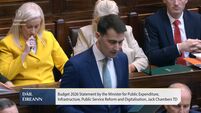Oliver Mangan: Optimism that central banks are moving to a less hawkish stance

The mood in markets has improved recently, with the decline in inflation in the US and weak economic data in Europe resulting in a scaling back of rate hike expectations, helping risk appetite.
Economic data has been giving some conflicting signals recently. Both headline and core inflation rates are easing in the US, while at the same time, they are hitting new highs in Europe, with the summer spike in gas prices there now feeding through into much higher electricity prices.
The US continues to print some strong data, most notably on jobs growth and consumer spending. GDP growth could accelerate in this quarter from the 2.6% annualised rate recorded in the last quarter.
By contrast, the UK is likely to be already in recession, with GDP expected to fall again in this quarter. Meanwhile, Eurozone GDP is expected to decline in this quarter and the opening quarter of 2023, pushing that economy into a technical recession.
The mood in markets has improved recently, with the decline in inflation in the US and weak economic data in Europe resulting in a scaling back of rate hike expectations, helping risk appetite. Markets now see US rates peaking at 5%, UK rates reaching 4.6% and Eurozone rates getting to circa 2.9%. Ten-year government bond yields have fallen by about 40bps in the US and UK in the past fortnight, with yields in most Eurozone markets down by circa 30bps.
Stock markets have performed strongly, with some key indices up by around 10% in the last month. One of the biggest market moves has been the US dollar which has lost significant ground recently as sentiment improved on markets.
The euro has risen from $0.975 at the start of the month to a $1.03-1.04 range, while sterling has climbed from $1.12 to $1.19. Meanwhile, the yen has staged a mini rebound, with the dollar falling from ¥149 to below ¥140.
We would be very slow, though, to sound the all-clear for markets despite the clear improvement in risk appetite, or to suggest that the dollar has embarked on a prolonged weakening trend. The US yield curve is becoming highly inverted, with 10-year rates falling well below two-year levels, which has often been a signal in the past of a looming recession.
Stock markets are likely to have to contend with the risk of a global recession in 2023, which would put company earnings under pressure. The main central banks look set to move to smaller rate hikes of 50bps in December and 25bps hikes in the New Year, before putting policy on hold in the spring. However, rates could become stuck at elevated levels, given it is expected to take some time for inflation to fall back to its 2% target.
In the very near term, optimism about central banks moving to a less hawkish stance and that inflation has peaked could see stock markets make some further gains. The dollar could also lose a bit more ground on positioning adjustments following the recent moves.
However, 2023 seems likely to be another challenging year for markets as they contend with the risk of recession, while at the same time central banks are hamstrung by high inflation, and unable to ease policy.
This sounds like a recipe for markets to remain volatile, with investors opting for safe havens like the dollar. We are by no means out of the woods yet.
- Oliver Mangan is Chief Economist with AIB














